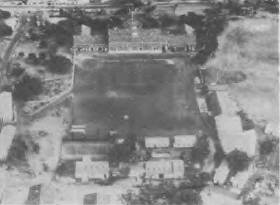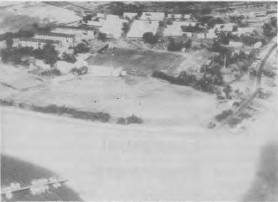- Author
- Jeffrey, Vic
- Subjects
- Ship histories and stories
- Tags
-
- RAN Ships
- HMAS Leeuwin, HMAS Leeuwin (base)
- Publication
- September 1990 edition of the Naval Historical Review (all rights reserved)
HMAS Leeuwin to many is well remembered as the home of the Junior Recruits or J.R.’s of the Royal Australian Navy. This year marks the thirtieth year since the first intake of J.R.’s at Leeuwin and to record this event a brief history written for the Decommissioning Ceremony of HMAS Leeuwin on 11th November 1986, by Vic Jeffery the Western Australian Navy PRO and Society member, follows:
The history of the Royal Australian Navy in Fremantle goes back to 1 July, 1911 when a District Naval Officer was appointed at Fremantle, primarily to administer Reserves enrolled for compulsory training.

The first District Naval Officer was Captain C.J. Clare and the Naval Staff Office was established in a disused Post Office in Cliff Street, Fremantle. In 1913 a building known as King’s Warehouse was leased from the Customs Department for use as a drill hall. This remained in use for 13 years until a new drill hall was constructed in an area bordered by Mouat Street, Croke Lane and Cliff Street. On 1st October, 1926 the new buildings were occupied by the District Naval Officer and his staff and King’s Warehouse was vacated.
At the outbreak of the Second World War the District Naval Officer became the Senior Naval Officer. At this time the Depot was known as HMAS Cerberus V (a fender to Flinders Naval Depot). The Naval Control of Shipping Service was established on 1 September, 1939 and a day later the Port War Signal Station on Rottnest Island was manned and mobilisation commenced.
Examination Vessels Emerald and Zephyr commenced operations on 5 June, 1940 the Italian MV Remo was seized.
The Croke Lane Depot was commissioned HMAS Leeuwin on 1st August, 1940. During 1941-42 much development occurred, including the building of the new and present depot at Preston Point to provide torpedo maintenance facilities for allied submarines and gunnery training for the Royal Australian Navy. This land had previously been partly WA Government Railway land along with Gallop’s farm on the Preston Point Road side. This was occupied on 1st July, 1942 following the appointment of Naval Officer-in-Charge Fremantle, the first being Commodore J.A. Collins

After the war and prior to Junior Recruit Training starting in 1960, the depot was mainly involved in the training of Reserves and National Servicemen. To this end the training ships HMA Ships Fremantle, Mildura and Junee were based in WA waters between 1951 and 1959. When the Naval Board decided to proceed with Junior Recruit training in 1959, HMAS Leeuwin which had existed in a semi-moribund state since the end of National Service in 1957 was their ultimate choice. By the end of 1959 HMAS Leeuwin once again began to take on the appearance of a naval establishment. In the short time available from January to July 1960, near miracles were performed in order to restore Leeuwin to a state fit to provide the necessary facilities for the accommodation and prescribed training of Junior Recruits.

On 18 July, 1960 the HMAS Leeuwin ceremonial gates were thrown open to receive the first 155 trainees. A total of 141 of that initial intake went on to graduate on 16 June, 1961 in the first Passing Out Parade which was reviewed by the late Vice Admiral Sir Henry Burrell, KBE, CB, RAN, Chief of Naval Staff. The number of Junior Recruits under training grew steadily in the 1960s reaching 619 in 1965 and eventually peaking at just over 800 in the early 1970s. The largest recorded intake was the 50th in 1974 consisting of 276 entries of which 229 went on to graduate. A long term development plan for HMAS Leeuwin was commenced in 1965 in a sweeping rebuilding programme which saw virtually all the temporary structures replaced with modern buildings.
Sadly the 1980s saw the decline of the Junior Recruit training scheme and the graduation of the 86th intake on 4th December 1984 saw the scheme placed in abeyance. A total of 13,340 Junior Recruit trainees entered HMAS Leeuwin between 1960 and 1984, of that number 12,074 graduated. Many have gone on to reach the senior ranks of the Royal Australian Navy.




